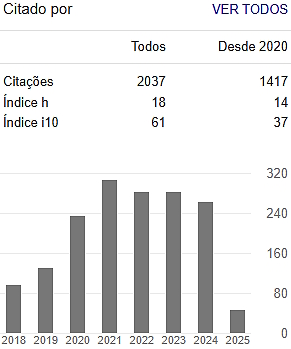MULTIVARIATE ANALYSIS IN THE SELECTION OF BARU GENOTYPES
Keywords:
Clustering, Biometry, Dipteryx alata Vogel, Plant breeding.Abstract
In terms of extension and flora, the cerrado is the second largest Brazilian biome and has native fruit species, which produce fruits with different characteristics, attractive colors and exclusive flavors, such as barueiro. However, the uncontrolled and unsustainable exploitation of the resources of this biome has been a cause of great concern worldwide. Given the importance and productive potential of the barueiro, it is necessary to characterize the fruits and seeds in the formation of seedlings through univariate and multivariate analyzes and frequency interval histograms in breeding programs. The design used was completely randomized, with seven populations of barueiros from the south and southeast regions of the state of Goiás, with five replications totaling thirty-five experimental plots, with fifteen fruits per replication. It was found that for the estimated mass of 100 fruits, estimated mass of 100 seeds and pulp thickness, the populations of Caldas Novas and Bom Jesus stood out for presenting higher averages in some characteristics evaluated. As for the frequency intervals, the greatest amplitude for seeds was observed in the population of Caldas Novas, while for the width, the greatest amplitude was observed in the population of Edéia. For fruits, the largest amplitudes were observed in relation to length and width for the population of Caldas Novas. After the genetic dissimilarity analysis, the UPGMA clustering method grouped the populations in such a way that one group was formed by the Caldas Novas and Bom Jesus populations and the other by the others. The highest correlation indices observed were mass of one hundred fruits and mass of one hundred seeds (87%) and seed length and fruit length (86%), respectively. In the grouping system using the k-means method, two groups were formed with Caldas Novas, Aloândia and Bom Jesus in one of the groups and the other group formed by the other populations.
Downloads
References
ALMEIDA, S. P. de. Cerrado: aproveitamento alimentar. Planaltina: Embrapa, p. 188, 1998.
BORGES, E. J. Baru a castanha do cerrado. Monografia (Especialização em gastronomia e segurança alimentar) – Centro de Excelência em Turismo, Universidade de Brasília. Brasília, p.155, 2004.
BORGES, K. C. F.; SANTANA, D. G. de; MELO, B. de; SANTOS, C. M. dos, Rendimento de polpa e morfometria de frutos e sementes de pitangueira-do-cerrado. Revista Brasileira de Fruticultura, v. 32, n. 2, p. 471-478, 2010.
CARDOSO, M. R. D.; MARCUZZO, F. F. N.; BARROS, J. R. Classificação Climática de Köppen-Geiger para o estado de Goiás e Distrito Federal. Acta Geográfica, v. 8, n, 16, p. 40-55, 2014.
CARRAZA, L. R.; ÁVILA, J. C. C. E. Manual Tecnológico de Aproveitamento Integral do Fruto do Baru. 2. ed. Brasília: Instituto Sociedade, População e Natureza, p. 56, 2010.
COUTINHO, G.; PIO, R.; SOUZA, F. B. M. de; FARIAS, D. H.; BRUZI, A. T.; GUIMARÃES, P. H. S. Multivariate Analysis and Selection Indices to Identify Superior Quince Cultivars for Cultivation in the Tropics. Hortscience, v. 54, n. 8, p. 1324–1329. 2019.
CRUZ, C.D.; REGAZZI, A.J.; CARNEIRO, P.C.S. Modelos biométricos aplicados ao melhoramento genético. Viçosa: UFV, 2004. 480 p.
FARIA, P. N.; CECON, P. R.; SILVA, A. R.; FINGER, F. L.; SILVA, F. F.; CRUZ, C. D.; SÁVIO, F. L. Métodos de agrupamento em estudo de divergência genética de pimentas. Horticultura Brasileira, v. 30, n. 3, p. 428-432, 2012.
FERREIRA, D. F. Estatística multivariada. Lavras: Editora UFLA, 2008. 662 p.
FERREIRA, D. F. Sisvar: a computer statistical analysis system. Ciência e agrotecnologia, v.35, n.6, p. 1039-1042, 2011.
GUEDES, M. N. S.; MARO, L. A. C. ABREU, C. M. P. de; PIO, R.; PATTO, L. S. Composição química, compostos bioativos e dissimilaridade genética entre cultivares de amoreira (Rubus spp.) cultivadas no sul de Minas Gerais. Revista Brasileira de Fruticultura, v. 36, n. 1, p. 206-213, 2014.
HAMMER, Ø.; HARPER, D. A. T.; RYAN, P. D. PAST: Paleontological Statistics Software Package for Education and Data Analysis. Palaeontologia Electronica, v. 4, n. 1, p. 1-9, 2001.
MICROSOFT CORPORATION. Microsof® Office Excel [Software]. Microsoft: Washington, 2010.
MYERS, N.; MITTERMEIER, R. A. MITTERMEIER, C. G.; FONSECA, G. A. B. KENT, J. Biodiversity hotspots for conservation priorities. Nature, v. 403, p. 853-858, 2000.
NEITZKE, R. S.; BARBIERI, R. L.; HEIDEN, G.; BÜTTOW, M. V.; OLIVEIRA, C. S.; CORRÊA, L. B.; SCHWENGBER, J. E.; CARVALHO, F. I. F. Caracterização morfológica e dissimilaridade genética entre variedades crioulas de melão. Horticultura Brasileira, v. 27, n. 4, p. 534-538, 2009.
OLIVEIRA, D. A.; PIETRAFESA, J. P.; BARBALHO, M. G. S. Manutenção da biodiversidade e o hotspots cerrado. Caminhos de Geografia, v. 9, n. 26, p. 101 – 114, 2008.
R Core Team (2021). R: A language and environment for statistical computing. R Foundation for Statistical Computing, Vienna, Austria. URL https://www.R-project.org/.
SANO, S. M.; RIBEIRO, J. F.; BRITO, M. A. Baru: biologia e usos. Planaltina: Embrapa Cerrados, p. 52, 2004.
SILVA, D. B.; SILVA, J. A.; JUNQUEIRA, N. T. V.; ANDRADE, L. R. M. Frutas do cerrado. Brasília: Embrapa Informação Tecnológica, 2004. 178 p.
SOKAL, R. R.; MICHENER, C. D. A statistical method for evaluating systematic relationships. University of Kansas Science Bulletin, v. 38, p. 1409–1438, 1958.
TAN, P. N., STEINBACH, M., E V.KUMAR Introduction to Data Mining. Pearson, 1st edition, 2006. 169 p.
VIEIRA, A. B.; COUTINHO, G.; BORGES, K. D. F. Biometria e qualidade fisiológica inter-específica de duas espécies de araticunzeiro do Cerrado. Magistra, v. 30, p.237 - 250, 2019.
VIEIRA, R. F.; AGOSTINI-COSTA, T. da S.; SILVA, D. B. da; SANO, S. M.; FERREIRA, F. R. (Ed.). Frutas nativas da região Centro-Oeste do Brasil. Brasília: Embrapa Informação Tecnológica, p. 322, 2010.
Downloads
Published
Issue
Section
License
Copyright (c) 2022 Colloquium Agrariae. ISSN: 1809-8215

This work is licensed under a Creative Commons Attribution-NonCommercial-NoDerivatives 4.0 International License.

